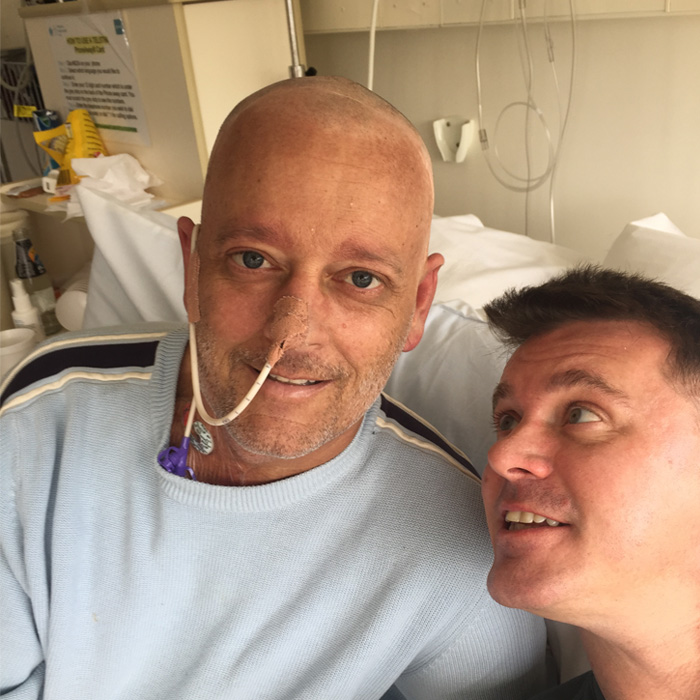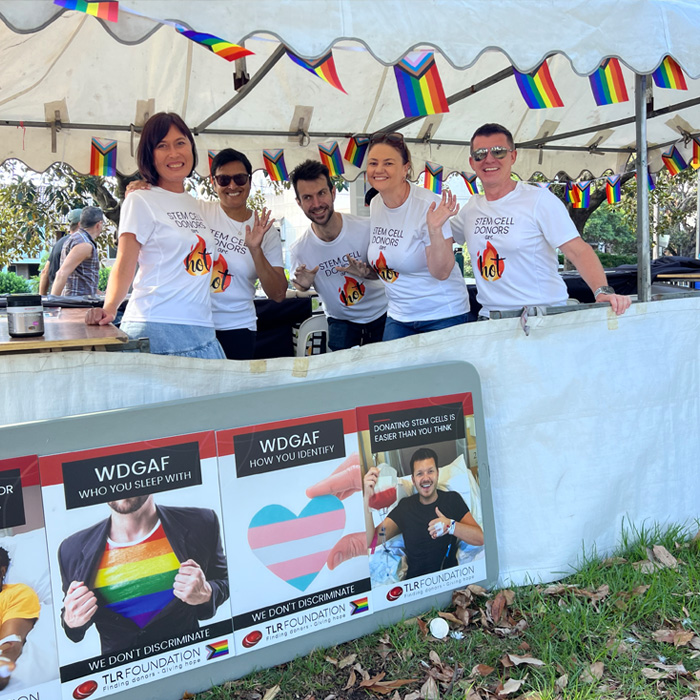Stem Cell Donation and the LGBTQIA+ Community
Your gender and sexuality make zero difference in saving a life
We welcome everyone! Think you can’t be a stem cell donor because you’re part of the LGBTQIA+ community? You’re not alone – and you’re not right either. While restrictions still apply to some things like blood donation, they do not apply to joining Stem Cell Donors Australia.
The TLR Foundation proudly stands with the LGBTQIA+ community – many of us are part of it. What matters in saving someone’s life isn’t who you are or who you love – it’s your age (18–35), your tissue type, and your willingness to help. Getting started is simple: just a few clicks online and a cheek swab kit gets mailed to your door. It’s easy, it’s important, and for someone with blood cancer – it could be everything.
1 in 1,500 The odds of being a perfect stem cell match for someone in need.
The percentage of Australian patients who currently rely on overseas donors.
3 out of 4 is the number of Australian patients who don’t find a local match on the registry.

A Legacy of Love & Action
When Neil lost his former partner, Trace Richey, following treatment for a blood cancer, he knew Trace’s story couldn’t end there. Trace was full of life, charisma, and compassion. He spent his entire career helping others – ironically, in the non-profit sector. In hospital, his fight was courageous and inspiring, and his gratitude to those around him never wavered – even in the most difficult moments. In the wake of heartbreak, Neil made a promise: to honour Trace’s life by helping others going through treatment for blood cancers and disorders. What began as a personal mission quickly turned into something bigger. Neil launched the All for Trace fundraising group, uniting friends, family, and strangers alike behind one goal: to raise $300,000 to fund a dedicated room in the Blood and Marrow Transplant Ward at St Vincent’s Hospital in Sydney – the very hospital where Trace was treated.
The campaign was bold and full of heart. There were head shaves. There was a skydiving fundraiser. And there were City2Surf runs – not just one, but many – a tradition that continues to this day. Every act, every donation, every event was fuelled by love – and by a deep desire to make a difference. Thanks to the incredible generosity of so many, that fundraising goal was achieved in under two years.
But Neil knew that wasn’t the end – it was just the beginning. Inspired by Trace’s legacy and the overwhelming support from the community, he and a group of dedicated friends established The TLR Foundation – named using Trace’s initials – to carry the mission forward.
The foundation exists to give hope to those facing blood cancers and other diseases by recruiting young and diverse stem cell donors, and supporting the nurses who care for them. At its heart, The TLR Foundation is about saving lives – and showing that love, resilience, and community can lead to real change.
Neil and Trace’s story is deeply rooted in the LGBTQIA+ community. It’s a story of two men who shared a life and a love, and who now share a legacy that’s saving others. The TLR Foundation continues to grow – educating, advocating, and inspiring the next generation of stem cell donors.
Trace may no longer be here – but through this work, his light shines on in every life that’s saved.

How Stem Cell Donation Works
Sign up to the register
It only takes a few minutes to join online through TLR Foundation’s sign-up page on Stem Cell Donors Australia. If you’re 18–35, you’re eligible – and you could be someone’s perfect match.
Swab at home
A cheek swab kit will be mailed to your door. Just follow the simple instructions, swab the inside of your mouth, and send it back – easy.
Match with a recipient
Your details are added to the national registry. If you're ever identified as a match for someone with blood cancer, you’ll get a call.
Donate stem cells
If you’re confirmed as the best match, you’ll be asked to donate. Most donations are done through a blood-like process called PBSC – it’s safe, supervised, and genuinely life-saving.
Relax and recover
Most people are back to their usual routine within a day or two. You’ll be looked after every step of the way – and you’ll have done something extraordinary.
FAQ's
What is stem cell donation and how does it work?
Stem cell donation is when a person gives healthy blood stem cells to someone whose own cells are not working properly due to illness, often blood cancer. It’s usually done through a process called PBSC, which is similar to donating plasma.
Stem cells are special cells found in your blood and bone marrow that can grow into different types of blood cells. Some people with blood cancers or disorders need a stem cell transplant to survive – and that’s only possible if a matching donor is found.
Once you’re matched with a patient in need, you’ll be asked to donate. In most cases, this involves having injections to boost your stem cells, then sitting comfortably while your blood is filtered through a machine to collect the stem cells. The rest of your blood is returned to your body. The whole process is safe, highly supervised, and for the person receiving your cells – potentially life-saving.
Can gay people donate stem cells or bone marrow in Australia?
Yes, in Australia, gay individuals are eligible to donate stem cells or bone marrow. Sexual orientation does not affect your ability to join the stem cell donor registry.
While certain restrictions apply to blood donation for men who have sex with men, these do not extend to stem cell or bone marrow donation. Eligibility is primarily based on factors such as age, health status, and medical history. If you’re between 18 and 35, hold a valid Medicare card, and are in good health, you can register to become a donor and remain on the registry until the age of 60.
By joining the registry, you could potentially save a life, regardless of your sexual orientation.
Are transgender, non-binary, or gender-diverse people eligible to donate stem cells?
Yes, in Australia, transgender, non-binary, and gender-diverse people are eligible to donate stem cells. Eligibility is primarily based on age, health, and medical history – not gender identity. If you’re aged 18 to 35, have a Medicare card, and are in good health, you can join the registry and stay on it until you’re 60.
While some restrictions apply to blood donation depending on sexual activity, these do not necessarily apply to stem cell donation. Most stem cell donations are done through a safe, supervised process similar to donating plasma.
Registration systems may still be catching up when it comes to gender identity options, but efforts are underway to make them more inclusive. If you’re unsure or have specific questions, it’s always okay to reach out directly to the registry – they’re there to help.
Why are more young male stem cell donors needed?
Young males are often preferred as stem cell donors because they’ve never been pregnant – which reduces certain risks for the patient during transplant. But regardless of gender, donors aged 18–35 are the most needed, and the more diverse the registry, the better the chances for every patient to find their match.
Pregnancy can expose the immune system to other cells, which may slightly increase the risk of complications after a transplant. That’s why doctors often request male donors when multiple matches are available – to reduce these risks.
That said, every registered donor has the potential to save a life. So whether you’re male, female, transgender, or non-binary – if you’re aged 18 to 35, your stem cells could be the match someone desperately needs.
Does taking PrEP or other HIV prevention medications affect my eligibility to donate stem cells?
Nope – if you’re taking PrEP (pre-exposure prophylaxis), you can still sign up to be a stem cell donor in Australia. It doesn’t automatically rule you out. If you’re ever identified as a match, the medical team will chat with you about what it means and make sure it’s safe for both you and the person who might need your cells.
PrEP is a powerful HIV prevention tool used by many in the LGBTQIA+ community. And while some medications can affect donation, PrEP isn’t an immediate barrier. As long as you’re 18–35 and in good health, you’re welcome to register – and we’ll work through the rest together if a match ever comes up.
How do I register to donate stem cells?
If you’re aged 18–35 and in good health, you can register online through Stem Cell Donors Australia. You’ll receive a free cheek swab kit in the mail – it’s quick, simple, and only takes a few minutes to complete and return. Once you’ve registered and returned your swab, you’ll be added to the national registry and could one day be called to save a life.
If you’re part of the LGBTQIA+ community and currently eligible to donate blood, you can also register in person during your next blood donation at Australian Red Cross Lifeblood – just let the staff know when you arrive.
You’re Eligible 🏳️🌈 Make It Count
Signing up as a stem cell donor is easy – and for someone with blood cancer, your decision could mean everything. If you’re aged 18–35 and in good health, your gender or sexuality makes zero difference – your potential to save a life does.